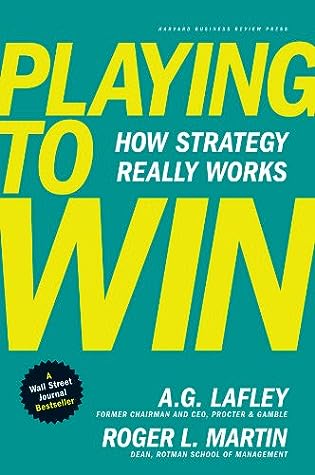More on this book
Community
Kindle Notes & Highlights
strategy is an integrated set of choices that uniquely positions the firm in its industry so as to create sustainable advantage and superior value relative to the competition.
Too often, CEOs in particular will allow what is urgent to crowd out what is really important. When an organizational bias for action drives doing, often thinking falls by the wayside.
The optimization of current practices does not address the very real possibility that the firm could be exhausting its assets and resources by optimizing the wrong activities,
Sameness isn’t strategy. It is a recipe for mediocrity.
Yes, clear, tough choices force your hand and confine you to a path. But they also free you to focus on what matters.
Winning should be at the heart of any strategy. In our terms, a strategy is a coordinated and integrated set of five choices: a winning aspiration, where to play, how to win, core capabilities, and management systems.
awareness precedes trial.
What is your winning aspiration?
Where will you play?
How will you win?
What capabilities must be in place?
What management systems are required?
a salesperson must make the best choices she can under constraints and uncertainty.
Aspirations are statements about the ideal future. At a later stage in the process, a company ties to those aspirations some specific benchmarks that measure progress toward them.
P&G’s statement of purpose, at the time, read as follows: “We will provide products and services of superior quality and value that improve the lives of the world’s consumers. As a result, consumers will reward us with leadership sales, profit and value creation, allowing our people, our shareholders, and the communities in which we live and work to prosper.”
the goal was innovation that drove the core.
Core was the first and most fundamental where-to-play choice—to focus on core brands, geographies, channels, technologies, and consumers as a platform for growth.
In great strategies, the where-to-play and how-to-win choices fit together to make the company stronger.
The goal is to uncover the unarticulated needs of consumers, to know consumers better than any competitors do, and to see opportunities before they are obvious to others.
There are many ways the higher-order aspiration of a company can be expressed. As a rule of thumb, though, start with people (consumers and customers) rather than money (stock price). Peter Drucker argued that the purpose of an organization is to create a customer,
Many handheld phone manufacturers, for example, would say they are in the business of making smartphones. They would not likely say that they are in the business of connecting people and enabling communication any place, any time.
The biggest danger of having a product lens is that it focuses you on the wrong things—on materials, engineering, and chemistry. It takes you away from the consumer. Winning aspirations should be crafted with the consumer explicitly in mind.
The push was to ask, “Who really is your best competitor? More importantly, what are they doing strategically and operationally that is better than you? Where and how do they outperform you? What could you learn from them and do differently?”
Competition will follow your technology, trying to at least match it and ideally beat it. Technical superiority alone is not sustainable.
The goal, then, is an integrated and mutually reinforcing set of capabilities that underpin the where-to-play and how-to-win choices and that are feasible, distinctive, and defensible.
The president would go through the deck, slide by slide, revealing the material to the mass audience in real time. We changed the meeting completely. It went from a formal presentation (by the business to management) to a dialogue focused on a very few critical strategic issues identified in advance.
The culture-busting kickers were threefold. First, there would be no presentation, only a discussion of the strategic issues agreed on in advance. Second, we limited the number of folks in the room, down from twenty-five to just four or five from the business plus the CEO and the corporate leaders who would bring specific experience or knowledge on the strategy issue. Third, participants would not be allowed to bring more than three new pages of material to the meeting to share


